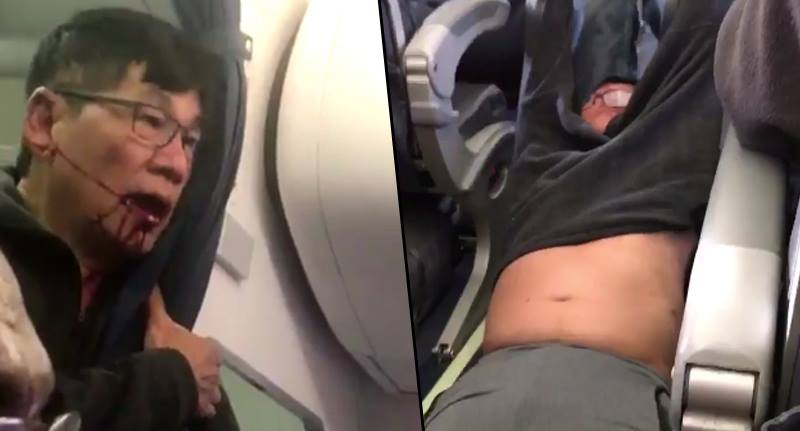It’s sometimes a challenge to work out the level at which we pitch our advice. Some clients are experienced media performers who want to step up a level. Others really need the basic building blocks to help them understand the fundamentals of communications. I wonder, if we worked in customer service, we would’ve been bold enough to open proceedings with a client as august as United Airlines with the line, ‘Don’t drag your customers out of their seats, break their teeth, and leave them with a bloody nose.’
The facts of the case are these: a United Airlines flight was overbooked and four crew members needed to be transported to make another flight. Passengers were offered money to give up their seats, and as none did so, passenger David Dao was selected to make way for a staff member. Dao refused on the grounds that he had patients waiting for him at his destination, and the matter was escalated to the point that Dao was forcibly removed from the plane by armed aviation police in an incident that Dao’s lawyer says left him bloodied, concussed, and with missing teeth.
The impact of the incident was a dramatic decline in United’s share price, a civil suit against the airline, and a huge hit to the company’s reputation when footage of the incident appeared on news websites, television, and social media. In the past, United might’ve got away with an incident like this, but in the days of Facebook Live, Periscope, and Snapchat, dramatic events are now nearly always captured on camera live at-the-scene, courtesy of the world’s growing army of citizen journalists.
Some stories are ‘sticky’ – the incident cannot be shaken off. When a Delta pilot struck a passenger on another flight on 21 April, less than two weeks after the United incident, the new story didn’t overtake the original; it merely dredged up the United incident again. United’s CEO Oscar Munoz reacted by, er, praising the actions of the employees during the incident.
Quite apart from hastily coming to the wrong conclusion, it was inevitable the letter would be leaked to the press – Munoz should’ve kept in mind that anything written down can and will end up being leaked to the media if it’s attached to a big story (and it was). By placing the emphasis on the employees rather than putting things right with the customer, Munoz gave the impression that United was taking a bunker mentality approach to the incident, and not looking out to the rest of the world. ‘Why do you hate the American people?’ one representative asked Munoz at the House Transportation Committee hearing, dangerous language in America’s currently jingoistic political atmosphere. This question came at a hearing held to discuss whether US airlines needed legislation to sort out customer service issues, or whether this could be achieved as an industry.
The United story has and will continue to create ripples, some of which circle back around in unexpected ways. For example, an unrelated story around a fast food restaurant gave the United board another cause for indigestion. When burger and chicken chain Wendy’s was approached on Twitter with the question ‘Yo @Wendys how many retweets for a year of free chicken nuggets?’ the company responded with a sensible answer, ’18 million.’ Customer Carter Wilkerson gave them their publicity and a warm, fuzzy feel-good story was created. Wilkerson’s plea has now been retweeted more than 3.5 million times and is the most retweeted tweet of all time. When United decided to try and get in on the Wendy’s game – by offering a free flight to Wilkerson – their ploy backfired spectacularly.
Twitter smelled cynicism and United got another mauling. It wasn’t just a communications misstep; it was a complete omnishambles: the incident with David Dao was immediately brought up again and the United brand faced further criticism. Why?
Our three golden principles of communication at PS Programmes are authority, authenticity, and audience. The airline has the authority to make things happen, whether that is a free flight or an out of court settlement – or doing the thing that you’ve paid them to do like honour the details on the ticket. The authenticity part of the equation is a bit more nebulous, but essentially, the actions and the words have to match up: you cannot say one thing and do another. Finally, you must take the audience reaction into account. United’s actions were an open invitation to the Twittersphere to turn the knife.
United was a classic case of the butterfly effect: the idea that seismic events can spring from small causes. ‘Businesses run complex systems so a small error in one part of the system can have an unpredictable large impact elsewhere,’ says Eric Priezkalns, a former Deloitte consultant and editor of Commsrisk. ‘Customers are more informed, more powerful than ever before because they can connect and act together like never before. United carries 143 million passengers a year but social media means one terrible incident can be global news – the butterfly effect!’
So what went wrong? A couple of things: while Dao may have settled out of court, the long-term damage for United is yet to be reckoned. The incident has truly gone viral, escaping the original context and appearing in other places to tell other stories – such as the front cover of an issue of the New Yorker.
Even if United’s settlement prevents Dao from being the voice of disgruntled customers, his bloodied face could be a lazy photo editor’s illustration of hostility in hospitality for years to come.
And by offering Wilkinson a free flight, United looked as though they were being excessively nice to one person, and excessively nasty to someone else. Twitter has seen the footage of Dao being dragged away, and an image paints more than 140 characters, let alone a thousand words. The free flight offer was too little, too late, to the wrong person, and in the light of Wilkerson’s tweet being one of the most retweeted of all time, too exposed. This hits the company’s authority and makes them look out of control, which is bad for a brand, and disastrous if you’re an airline.
United also looked like they were piggybacking on someone else’s success to remedy their damage. This is a gut punch to all ideas of authenticity. United needs a campaign that is original, gets traction, and puts things right with the customer – not necessarily Dao, but something that speaks to people like him. It needs to come from the heart. Think about why Wilkerson and Wendy’s are doing so well. He’s 16, and is cheekily asking for a freebie. Wendy’s has laid down a challenge, and he’s accepted. There are no great stakes here – it’s a bit of fun with a teenager with chutzpah (and we all know someone like that) and a fast food place that most people are familiar with. When United offered to throw in an unasked for free flight, it felt like a figurative smack in the face to customers like Dao who have paid for a ticket and been treated badly.
To top off this perfect storm, United crucially misunderstood the audience they were reaching. Travellers don’t want to be pulled from their seats, and they don’t regard being beaten up as something that can be put right in a playful Twitter game. United’s future customers don’t want to see a faceless big business cynically wooing their dollar with a freebie flung at someone who only seems to be getting it because they’re momentarily famous.
United have to do a lot of work to rebuild their reputation and it won’t happen overnight. They need to face their responsibility (authority), and make genuine reparations (authenticity) in a way that speaks to their core customers (audience). Or they can hope it all goes away and people forget about it. A risky strategy… even the self-acknowledged king of the PR gaff Gerald Ratner never got things THAT wrong.
This article appears on Nadine Dereza’s website as well as PS Programmes.






